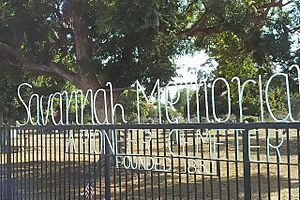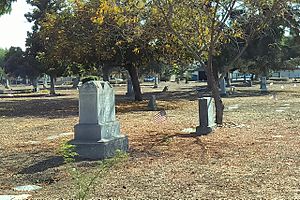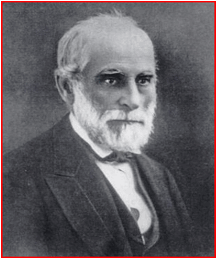Savannah Memorial Park facts for kids
Savannah Memorial Park is a very old cemetery in Southern California. It is also known as El Monte Memorial Park or the Savannah Pioneer Cemetery. This park is special because it was one of the first cemeteries in the area that wasn't linked to a specific church.
You can find the park in Rosemead, California. Part of it is also in the nearby city of El Monte. People have been using this park since it started in 1850. Some graves might even be older, from the 1840s. Because of its long history, Savannah Memorial Park was named a California Historical Landmark in 2012.
Contents
The Park's Beginnings
The story of Savannah Memorial Park began around 1846. A man named Henry Dalton owned a large piece of land. On his property, he found two graves surrounded by cactus plants. He decided to set aside about two acres of land for a cemetery.
Henry Dalton was a successful merchant. He bought many properties in the Los Angeles and San Gabriel Valley areas. He and his wife, Maria, brought food products from all over the world to their home. Henry Dalton was also known for bringing avocados and grapevines to the San Gabriel Valley. He even imported honey bees from Italy!
In 1851, Henry Dalton officially gave the land for the cemetery to the city. Before the American Civil War, many families from the Southern United States moved to El Monte and Rosemead. El Monte was once called Lexington, and Rosemead was known as Savannah. Savannah Memorial Park is thought to be the oldest Protestant cemetery in Los Angeles County.
Who Manages the Park?
Today, the El Monte Cemetery Association takes care of the park. This group is a non-profit organization. They look after more than 3,700 graves in the four-acre cemetery. The association gets money from donations and special events.
The park is also important because it's near the end of famous old trails. These include the Santa Fe Trail and the Southern Emigrant Trail. It was also on a route used to bring supplies to the Mission San Gabriel Arcángel long ago.
Every May, the American Legion Post #261 and Post #748 hold a Memorial Day ceremony at the park. This event honors those who served in the military.
Important Markers and Tributes
Savannah Memorial Park has several special markers that tell its story.
California Historical Landmark Plaque
A special plaque marks the park as a California Historical Landmark. It says: Established in 1851, on the spot where Henry Dalton’s land grant showed "the American graveyard”, Savannah was the first public burial site used by settlers who came to the San Gabriel Valley by wagon train. Many of these pioneers were instrumental in developing the educational, social, and legal foundations of Southern California. Their family names are commemorated in the names of streets, buildings, and parks throughout the area. These pioneers formed the foundation of the American presence in El Monte, Rosemead, and the surrounding San Gabriel Valley.
This plaque explains that the park was the first public burial site for early settlers. These pioneers helped build the schools, communities, and laws of Southern California. Many streets and buildings in the area are named after these important families.
Pioneer Memorial Rock
There is also a large rock and a plaque dedicated to California Pioneers. The El Monte Cemetery Association placed it there on May 30, 1922. It honors the brave people who first settled in the area.
War Veteran Cannon
On July 2, 1929, a special ceremony took place. A large cannon was placed next to the park's flagpole. This cannon was brought from the Benicia Arsenal. It serves as a memorial to the war veterans buried at Savannah Memorial Park.
Notable People Buried Here
Many interesting people are buried at Savannah Memorial Park. They include pioneers, war veterans, and community leaders.
- Sergt. John “Jack” Guess, Jr. (1891–1918): He was wounded in World War I. He was one of the first Anglo-Saxon settlers in Rosemead, arriving in 1852. He built the first schoolhouse in Los Angeles County, called Savannah School.
- Veterans from US Wars: The park is home to veterans from many American wars. This includes soldiers from the War of 1812 all the way up to more recent conflicts.
- Wiley R. Wilson (1800–1878): A veteran of the War of 1812.
- Andrew Jackson King (1833–1923): A lawman, lawyer, and judge.
- Asa Ellis (1817–1890): He served in the California state assembly several times.
- Charles E. Wiggins (1927–2000): A monument here honors this US Representative and United States Circuit Judge.
- Hazen Aldrich (1797–1873): A leader in a branch of the Latter Day Saint movement.
- Robert Tweedy, Sr. (1811–1899): A pioneer settler who came from Arkansas in 1852. He acquired land that became part of South Gate. Tweedy Blvd. is named after him.
- Archie N. Wiggins (1863–1927): Known as the "Watermelon King of El Monte." He was one of the few American children to attend the Old Mission school. He helped develop schools in El Monte.
- Thomas Mayes Wiggins (1873–1937): A jockey who raced horses at the annual Tournament of Roses Rose Parade.
- Benjamin F. Maxson (1841–1899): A Civil War veteran and a successful walnut farmer.
- Dr. Elgar Reed (1866–1924): A doctor who helped during a smallpox outbreak in the San Gabriel Valley.
- P. W. Shropshire (1876–1959): One of the last veterans of the Spanish–American War.
Images for kids





